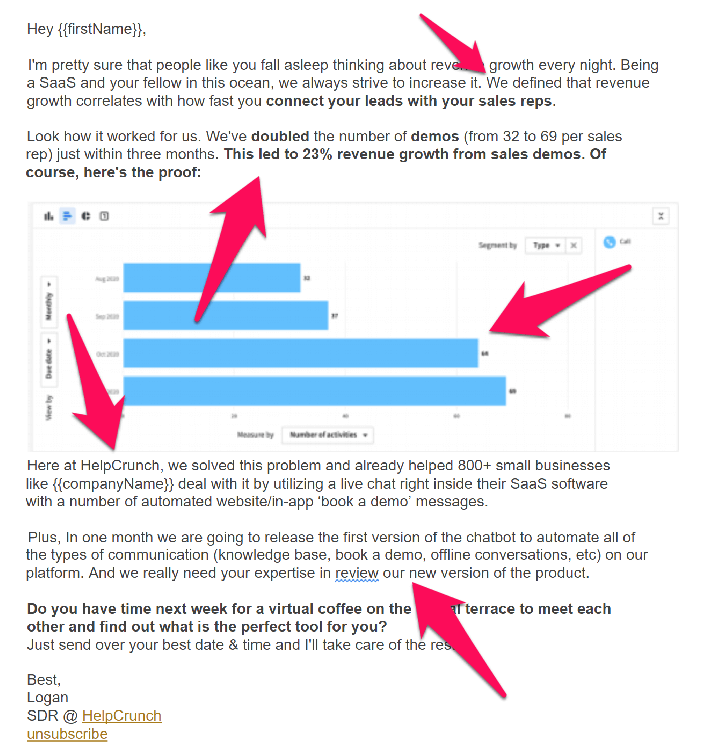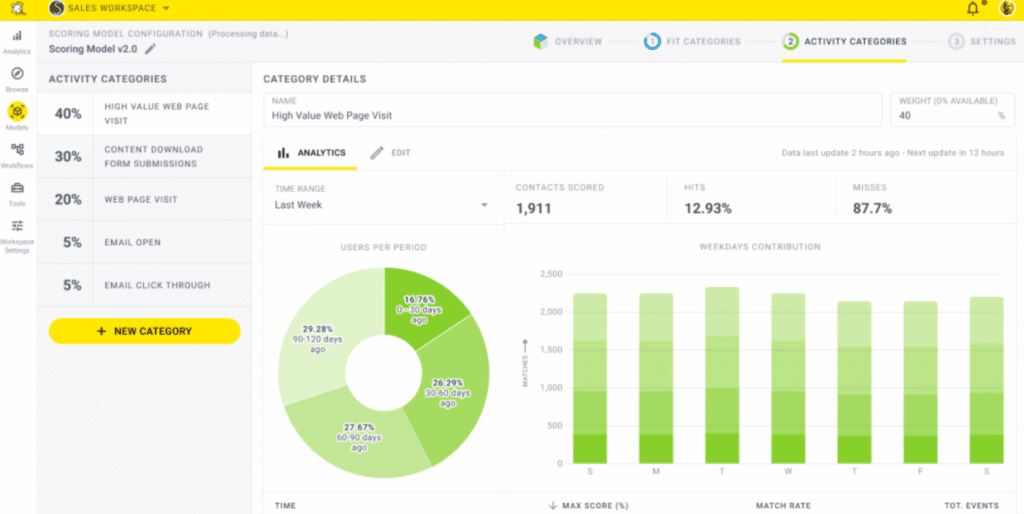Imagine supercharging your sales team with data-driven insights and strategies–that’s the power of sales analytics. As a sales leader, you’ll want to understand and utilize them.
As a field, sales has always been dynamic—constantly evolving and adapting to market trends, customer data, and technological advancements. Once heavily reliant on gut instincts and personal connection, the art of selling is increasingly turning to data for direction.
This is where ‘sales analytics’ enters the picture, taking center stage in this shift.
Sales analytics is not just a buzzword; it’s a powerful tool to stir up how sales teams operate. It’s all about harnessing the power of present and historical data to understand customer behavior, track product performance, identify opportunities, and make strategic decisions.
So, buckle up and join us on this exciting journey as we delve deeper into sales analytics. We’ll focus on why every sales team must embrace analytics and how it can push your sales efforts to new heights.
Let’s dive in!
What is Sales Analytics?
Sales Analytics is essentially the Swiss Army Knife in your sales toolkit. It’s the act of collecting, processing, and analyzing data to make informed sales decisions. When you perform sales analysis, think of it as your GPS, guiding you on the best route to reach your sales goals.
It helps you understand customer behavior, evaluate your team’s performance, identify trends, and forecast future sales. By leveraging sales analytics, you’re not just shooting in the dark; you’re making strategic, data-driven decisions that can significantly boost your sales and overall business performance.
The Evolution in Sales: From Intuition to Analytics
Remember the good old days when sales was all about who you knew and how well you could read a room? Back then, a salesperson’s toolkit was filled with a charming smile, a firm handshake, and a killer instinct for closing deals. It was all about building relationships and trusting your gut.
Fast forward to today, things have taken quite a turn. With the tech boom came a flood of data. Suddenly, we’re swimming in a sea of information, and guess what? It’s changed the game for sales big time.
Now, being a salesperson isn’t just about schmoozing clients and trusting your sixth sense. It’s about understanding and using data. We’re talking about spotting patterns, identifying trends, and using these gold nuggets of information to make smarter sales decisions and inform your talking points.
Being a modern salesperson is like being a part detective, part analyst, and part charmer. You still need those relationship-building skills and that persuasive charm, but you’ve also got to be able to crunch numbers and interpret data.
Sales has evolved from a purely instinct-driven game to one that’s powered by analytics. But don’t worry, it’s not as scary as it sounds. In fact, it’s pretty exciting. By combining the wisdom of the past with the insights of the present, you’ve got yourself a recipe for sales success. And who doesn’t want a piece of that pie?
The Power of Sales Analytics
Sales Analytics is like the superhero of the sales world. It swoops in, saves the day, and makes your sales processes. But just like every superhero, it has its own set of superpowers. Let’s dive in and explore them!
Enhanced Decision-Making Through Sales Analytics
One of the greatest powers of sales analytics is its ability to guide decision-making. No more guessing or relying on hunches. With data at your fingertips, you can make informed decisions backed by solid evidence.
Imagine you’re a sales rep about to pitch to a client. Instead of a one-size-fits-all pitch, you use data insights to craft a personalized message. You know what products they might be interested in, and the best time to contact them. This isn’t just a shot in the dark; it’s a targeted approach that’s much more likely to hit the bullseye.

Performance Monitoring and Improvement
Sales analytics also plays a crucial role in understanding how your team is performing. By analyzing data, you can identify patterns, strengths, weaknesses, and areas for improvement.
Are some reps consistently outperforming others? What strategies are they using that can be replicated? Where are there gaps that need to be addressed? Sales analytics helps answer these questions, enabling you to continuously improve your strategies and up your sales game.
Predictive Capabilities of Sales Analytics
Sales analytics has an uncanny ability to forecast sales trends. Predictive analytics is taking what you’ve learned about past sales and using it to gauge patterns and trends. This allows you to make educated predictions about your sales funnel.
Understanding when to check in with prospects can mean all the difference between closing a sale or not. By leveraging huge volumes of historical sales data, predictive analytics can alert sales reps when to check in with prospects.

But the magic of sales analytics doesn’t stop at predictive analytics. It also enables a significant shift in your sales strategy–from reactive to proactive.
Traditionally, sales strategies have been reactive. You wait for something to happen, then you react. Sales pipeline velocity increases? You react. Revenue generated is down? You react. But with the predictive capabilities of sales analytics, you’re no longer just responding to changes; you’re anticipating them.
This proactive approach allows you to stay one step ahead of the game. You can anticipate market changes, customer satisfaction, and even the actions of your competitors, and plan your strategies accordingly. It’s like playing chess, where you strategize several moves ahead.
Challenges in Integrating Sales Analytics
While sales analytics can be a game-changer for businesses, integrating these tools into your sales process is not without its challenges. Let’s explore some of the common hurdles and how to navigate them.
Data Overload and Reliance
In the age of Big Data, there’s no shortage of information at your fingertips. But, too much data can sometimes lead to sales analysis paralysis. Sifting through mountains of data and finding what’s relevant and valuable can be overwhelming. You might find yourself drowning in numbers, charts, and graphs, losing sight of your sales objectives.
Moreover, while data is invaluable, it’s crucial not to sideline the human element in sales. Remember, behind every sales data point is a customer with unique needs, preferences, and emotions. It’s essential to balance relying on data and nurturing genuine human connections to increase customer lifetime value. Utilizing a data room for efficient organization and access to critical information can aid in streamlining this process.
Identify Relevant Metrics
Another challenge with sales analytics is identifying which metrics are truly relevant to your sales goals. Not all data is created equal, and focusing on the wrong metrics can lead you down the wrong path. For example, if you’re only looking at the number of leads generated, you might miss out on the quality of those leads, resulting in wasted resources and missed opportunities.
Furthermore, misinterpretation and misapplication of data can lead to poor decision-making. Understanding the context behind the numbers and applying your findings appropriately to your sales strategy is crucial.
The Need for Training
To reap the benefits of sales analytics, your team needs to know how to use these tools effectively. This requires training, which can be time-consuming and costly. But consider this an investment rather than an expense. By equipping your team with the right skills, you’re setting them up for success in the long run.
Best Sales Analytics Tools for 2023
We’ve seen how sales analytics provide actionable insights into customer behavior, sales team’s performance, and market trends, empowering businesses to make informed decisions. With these tools, sales teams can identify opportunities, optimize their strategies, and drive more revenue.
If you’re looking for a sales analytics tool, here are five of the leading players in the industry:
- Salesforce Sales Cloud: Salesforce is a leading CRM platform that provides powerful sales analytics capabilities, helping businesses track customer interactions, improve forecasting accuracy, and make data-driven decisions.
- HubSpot Sales Hub: HubSpot Sales Hub brings all your sales data to one place, making it easier to analyze. It offers tools for pipeline management, email tracking, and scheduling, along with detailed analytics to help optimize your sales process.
- Gong: Gong uses AI to analyze sales calls and meetings, providing insights into what works and what doesn’t in your sales conversations. It can help improve deal outcomes, ramp new hires faster, and replicate successful tactics across your sales team.
- Zendesk Sell: Zendesk Sell is a sales CRM designed to improve productivity, processes, and pipeline visibility for sales teams. It also offers robust sales analytics capabilities to help you understand trends and drive performance.
- Breadcrumbs: Breadcrumbs is a sophisticated lead-scoring tool designed to help sales teams prioritize leads and identify the best opportunities. It tracks firmographics and engagement data from various sources, giving detailed insights into sales-qualified leads.
Why Your Sales Team Needs Analytics
In conclusion, sales data are incredibly important in today’s sales landscape. As we navigate an increasingly data-driven world, sales teams must harmonize traditional sales methodologies with sophisticated sales analytics tools.
Integrating these two components enhances decision-making processes and increases sales productivity, leading to improved performance and revenue growth.
Therefore, sales teams must embrace the power of analytics and its potential to transform their operations and outcomes to stay competitive and drive growth.
Analytics offers sales leaders a clearer vision, a deeper understanding of their audience, and a roadmap to achieve their goals.
FAQs
How are analytics used in sales?
Analytics in sales are used to gather and interpret data related to sales performance. This can include tracking and analyzing historical sales data, customer behavior, sales team performance, and more. The actionable insights gained from this data can help identify opportunities for growth, improve key sales metrics, enhance customer relationships, and ultimately drive more revenue. Sales analytics can also aid in forecasting future sales growth trends and making informed business decisions.
What is the role of data analytics in sales and marketing?
Data analytics plays a crucial role in sales and marketing by providing valuable insights into customer behavior, market trends, and campaign performance. In sales, data analytics can help identify high-performing products, track sales metrics, and forecast future sales. In marketing, it can measure the effectiveness of marketing campaigns, understand customer preferences, and segment customers for targeted marketing. Sales analysis enables sales and marketing teams to make informed decisions, optimize strategies, and improve overall performance.
What are the benefits of sales analytics?
There are several sales analytics benefits. They support improved decision-making by offering insights based on data, which can guide a successful sales organization. They also have the potential to boost sales by identifying key trends and patterns.
Sales data can also enhance customer relationships by providing a deeper understanding of customer behavior and preferences, allowing businesses to customize their approach accordingly. Moreover, they enable businesses to predict future sales trends, facilitating effective planning. Companies can allocate resources more efficiently by pinpointing what sales data is working and what needs improvement.
Lastly, the insights gathered from a sales analysis can offer businesses a competitive edge by helping them comprehend the market landscape better.
What is sales data analysis?
When you perform sales analysis, you collect, process, and interpret sales data related to sales activities. It involves examining sales reports, market trends, customer behavior, and other relevant historical sales data to gain insights into sales performance. Sales data analysis aims to identify patterns and trends that can help improve sales strategies, forecast future sales, enhance customer relationships, and ultimately drive business growth.
For example, sales reps might perform different sales analytics related to different goals. For example, meeting the current quarter’s target may require a sales pipeline analysis to determine which customers are most likely to close.
